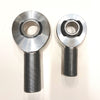Understanding Heim Joints: A Guide to Their Function and Benefits

Understanding Heim Joints: A Guide to Their Function and Benefits
Heim joints, also known as rod ends, are an essential component of many mechanical systems. These joints are used to connect a control rod or linkage to a pivot point, allowing for rotational movement while maintaining alignment. In this blog post, we'll explore the function and benefits of heim joints, and how they can be used in various applications.
Function of Heim Joints
Heim joints consist of a spherical ball with a threaded shank or stud, which allows them to be attached to a control rod or linkage. The spherical ball allows for a wide range of movement in all directions, while the threaded shank or stud allows for easy attachment and removal. The use of heim joints allows for precise control of mechanical systems, making them essential in many applications.
Benefits of Heim Joints
- High Load Capacity
Heim joints are designed to handle high loads and stresses, making them suitable for heavy-duty applications. They are commonly used in suspension systems, steering systems, and other applications where strength and durability are essential.
- Precision Control
Heim joints provide precise control over the movement of mechanical systems. Their ability to rotate in all directions allows for precise adjustments to be made, which can be critical in certain applications. This precision control can improve the overall performance of a system and reduce the risk of failure.
- Easy Replacement
Heim joints are designed to be easily replaced when necessary. Their threaded shank or stud allows for easy attachment and removal, which can save time and reduce the need for specialized tools.
- Versatility
Heim joints come in a wide range of sizes and configurations, making them suitable for a variety of applications. They can be used in anything from industrial machinery to race cars, and are available in both male and female configurations.
Applications of Heim Joints
Heim joints can be used in a variety of applications, including:
-
Suspension Systems: Heim joints are commonly used in suspension systems to connect control arms to the chassis or steering components. They provide precise control over the movement of the suspension, which can improve handling and stability.
-
Steering Systems: Heim joints are also used in steering systems to connect the steering column to the steering linkage. This allows for precise control over the direction of the vehicle, which can improve handling and safety.
-
Industrial Machinery: Heim joints are used in a variety of industrial machinery, such as conveyor systems and robotic arms. Their ability to handle high loads and provide precise control makes them essential in many manufacturing applications.
In conclusion, heim joints are an essential component of many mechanical systems. They provide precise control over the movement of a system, are designed to handle high loads and stresses, and are available in a wide range of sizes and configurations. Whether you're working on a race car or industrial machinery, heim joints can help you achieve precise control and improved performance.





